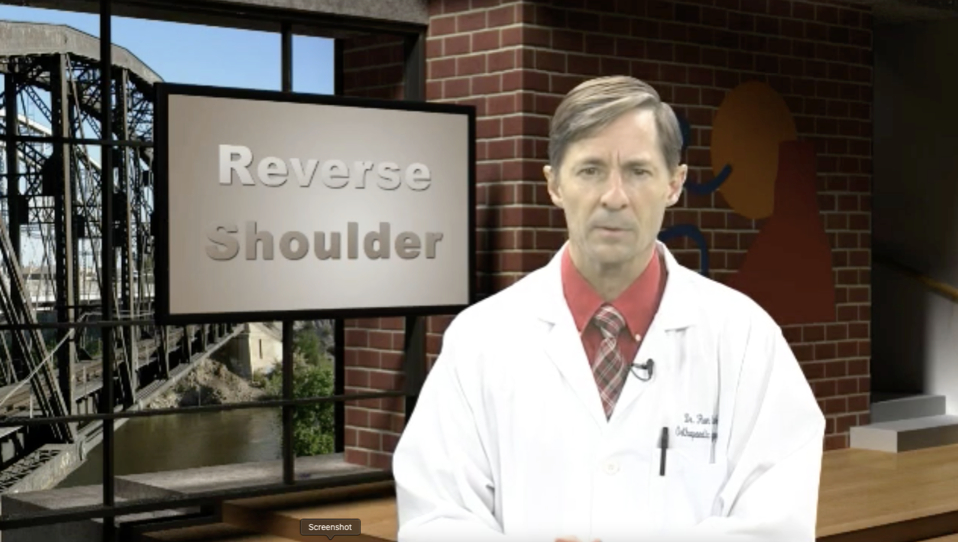What You Need to Know About Reverse Shoulder Replacement
November 16, 2022
Hello and welcome to Yuma Health and Happenings. I’m Dr. Ron Clark, Orthopedic Surgeon and founder of The Bone and Joint Center of Yuma. Today I want to talk about the shoulder with its complex form and functions. We’ll also discuss what happens when the shoulder stops performing those functions.
Functions of the Shoulder
The shoulder is comprised of three separate bones, the arm bone, the shoulder blade bone, and the collar bone. The shoulder is connected to the rest of the body by the inner end of the collar bone and supported by muscles that connect to the neck and upper back.
The shoulder blade is completely covered by muscles and lies on the back of the rib cage. The major joint of the shoulder is where the arm bone and the shoulder blade meet but the end of the collar bone also connects with the shoulder blade bone at a different location and is also a flexible joint.
The fact that the shoulder blade can glide over the rib cage makes for a third joint and increases the movement that our arms can make. The surface covering the arm bone and shoulder blade socket is called joint cartilage and is 70% water. This surface allows the two ends of the bone to move smoothly over each other.
Because the upper end of the arm bone is round and the shoulder blade bone forms a shallow cup, the shoulder is considered a ball and socket joint. This explains how we can use our shoulders to move our hands nearly all around our head and body and is the joint of the body with the greatest amount of movement.
Since the socket side of the joint is much smaller than the arm bone is, a great deal of force and energy can be passed through the muscles and tissues that hold the shoulder together.
Diagnosing Common Shoulder Issues
Many of the common shoulder problems occur around the muscles and the tissues that are supposed to hold the shoulder bones together. As we age, the muscles and tendons around the shoulder will sometimes fray like a rope and eventually separate from the bone.
Because the shoulder has several muscles that work simultaneously, the separation and loss of muscle strength in the shoulder may not be realized until the symptoms of pain and loss of movement reach a point where they seek professional care. Many times, individuals will think that they are just toughing out the aches and pains of advancing age and may be experiencing a permanent loss of muscle function in the shoulder.
When there has been a loss of the attachments of the shoulder muscles, the joint will be out of balance and the joint surface will be over stressed and it too will begin to wear abnormally. Sometimes I must give individuals the bad news that their shoulder pain has been caused by both arthritis and a damaged muscle attachment. This combination of circumstances is called cuff tear arthropathy or simply arthritis resulting from a damaged rotator cuff attachment.
This entity is rare before the age of 60 and can happen without warning throughout life; it most commonly occurs between the ages of 70 through 85. While conventional shoulder replacement surgery is very helpful for those with arthritis and who have normal muscles around the shoulder, individuals who have lost the rotator cuff attachment do not have a predictable return of movement to their shoulder after conventional surgery and are often disappointed with their shoulder afterwards.
Shoulder Replacement Treatments
To address the limited movement possible after a conventional shoulder replacement, a unique design of the shoulder implant was developed that switches the position of the ball and joint socket into a reversed position. This means that instead of the arm bone having a rounded ball like surface, it is replaced with a cup-shaped socket. The shoulder blade surface is also replaced with a small ball to replace the normal socket of the shoulder. This design has been named the reverse shoulder replacement.
By reversing the implant positions, one of the large shoulder muscles that is stronger than the rotator cuff now will act as a lifter of the arm and will restore movement that otherwise would not be possible. While the overall function of the shoulder will not be normal with the reverse shoulder replacement, it has been shown to be much better than the results obtained with the conventional shoulder replacement in individuals that have lost the function of the rotator cuff.
Sometimes there are fractures to the top of the arm bone that shatter the bone where the rotator cuff attaches. When this happens in older individuals, healing is sometimes unpredictable or fails to occur and the person is left with a stiff shoulder after the bone heals. For these challenging situations, the reverse shoulder replacement has been recognized as reliably returning function in a predictable fashion for such devastating injuries.
The option of whether to undergo any type of surgical procedure needs to be made carefully by both the surgeon and the patient. All surgical procedures have risks and infection, joint stiffness, or weakness can occur after any type of shoulder procedure.
Fortunately, reverse shoulder replacement has demonstrated a significant improvement in the relief of pain and function for those with arthritis and muscle damage.
For more information on reverse shoulder replacements, schedule an appointment with The Bone and Joint Center of Yuma.